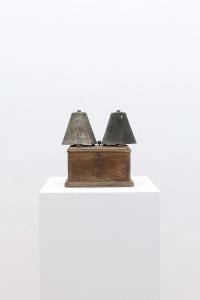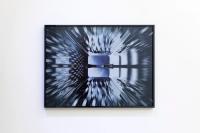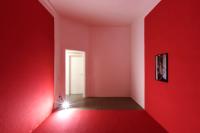Works




Installation Views
Press Release
In the past years, Emanuel Rossetti has repeatedly built and outlined abstract architectures. While some of these have been realized as actual environments, others appeared as fragments, singular images, or objects. In this engagement with spatial contingencies, Rossetti continues to delineate both lived-in and imagined spaces to further meditate on the symbolic value of spatialized objects and structures. For the exhibition Delay Dust (2014), Rossetti installed Vomitory, a red space at the entrance of Kunsthalle Bern. Concealed exits functioned as passages to the rest of the building, which remained, for the most part, empty. “Crossing the carpeted threshold,” wrote the curator, “down to the ensuing rooms (...) one finds oneself in the twilight zone.1“ While the metaphor of an in- between state generously lends itself to discuss Emanuel Rossetti’s practice, I would, respectfully, disagree. For me, the experience of the twilight zone, or the in-between sensation, didn’t occur in the moment of passing from the red to the other rooms, instead it was already established before, in the red space itself.
This slight but pertinent distinction relates to the other elements that—besides the red carpeting —shaped the experience of Vomitory. Firstly, it was filled by the presence of a droning sound coming from loudspeakers within and beyond the red space, and five metal bells (Gallery Bells, 2014) laid out in a zig-zag formation on one of its floors. But mostly, it was physically occupied by two sarcophagi2—these appearing like cut-outs—linking the host architecture to the frame of the red floor-to-wall carpets which projected itself as a reification of a virtual space. In this set-up, one could debate which reality was actually augmented, the constructed one or the one we call real. More precisely, this bridging of environments, the real and the imagined ones, enhanced the visibility of both the structure and its surrounding architecture, allowing for a sort of twilight experience.
As a gateway, Vomitory functioned by emphasizing the spilling of the audience into the exhibition spaces, which were, in turn, underwhelmingly void. Conversely, for Hypnic Jerk, the entry-way gallery at Jan Kaps begins with a viewing of a small heap of objects, hung on walls and placed on pedestals. And, in a reverse proposal, the artist installed Vomitory 2 (2017), another instance of the red room, this time at the end of the gallery. Again, Vomitory 2 incorporates the room’s heating radiator. But where the red space in Bern reified the potentiality of virtual spaces, Hypnic Jerk’s cul-de-sac aborts the notion of the possible. This time, there is literally no way out. In light of the potential of augmented realities, this renewed proposal acts as a reminder of the manifold possibilities enabled by our alert senses and what we’re ultimately left with to navigate the world. More than a few of the works in Hypnic Jerk stress the limitations of connectivity. Like switched-off atrocities, these works manipulate the imaginary and relate them back to the deadlock of our daily lives. In the rendering of a household item like a cheese grater (Hurdy Gurdy, 2017), the artist simulates motion blur and cynically glorifies the abrasion of time and space. Equally, a disfigured designer teapot (Ubu, 2017) or a disconnected rotary dial telephone (Hypnic Jerk, 2017), sitting in solitude and dysfunctional, underline the expiration date of things. In Bern, the artist delayed the dust and in Cologne he lets it settle.
Even though, thoughts might be winding down slowly, the shift between the awakened state and the land of slumber happens quite abruptly. But sometimes, right before falling asleep, the body twitches in futile rebellion, a hypnic jerk. The heart speeds. In a relentless instant the body acts up and gasps for life one last time, before disconnecting and inducing its dreams. Like a warning or the ringing of an inner alarm clock, such twitches pose as reminders of how the time asleep—and conversely alive—is only temporary.
Tenzing Barshee, 2017
1 In the press release for Delay Dust, the curator Fabrice Stroun identifies the moment of the twilight zone happening when stepping from the red space into the rest of the building. 2 The showcasing of the sarcophagi, which contain radiators, nods towards Michael Ashers’ installation Kunsthalle Bern, 1992, (1992) for which he exhumed all the building’s heaters and arranged them in the same position where Rossetti installed his red environment.








